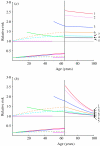Repeated influenza vaccination of healthy children and adults: borrow now, pay later?
- PMID: 16409652
- PMCID: PMC2870374
- DOI: 10.1017/S0950268805005479
Repeated influenza vaccination of healthy children and adults: borrow now, pay later?
Abstract
A growing number of publications are recommending annual influenza vaccination of healthy children and adults. However, the long-term consequences of repeated influenza vaccination are unknown. We used a simple model of recurrent influenza infection to assess the likely impact of various repeated influenza vaccination scenarios. The model was based on a Markovian framework and was fitted on annual incidence rates of influenza infection by age. We found that natural influenza infection reduced the risk of being re-infected by 15.4% (95% confidence interval 7.1-23.0). Various scenarios of repeated influenza vaccination were then simulated and compared with a reference scenario where vaccination is given from age 65 years onwards. We show that repeated vaccination at a young age substantially increases the risk of influenza in older age, by a factor ranging between 1.2 (vaccination after 50 years) to 2.4 (vaccination from birth). These findings have important implications for influenza vaccination policies.
Figures


Similar articles
-
Impact of influenza on young children and the shaping of United States influenza vaccine policy.Pediatr Infect Dis J. 2003 Oct;22(10 Suppl):S231-5. doi: 10.1097/01.inf.0000092194.33331.66. Pediatr Infect Dis J. 2003. PMID: 14551482 Review.
-
Influenza vaccination coverage among children and adults - United States, 2008-09 influenza season.MMWR Morb Mortal Wkly Rep. 2009 Oct 9;58(39):1091-5. MMWR Morb Mortal Wkly Rep. 2009. PMID: 19816396
-
Prevention of influenza: recommendations for influenza immunization of children, 2006-2007.Pediatrics. 2007 Apr;119(4):846-51. doi: 10.1542/peds.2007-0164. Pediatrics. 2007. PMID: 17403861
-
Health and economic impact of the seasonal influenza vaccination programme in England.Vaccine. 2012 May 14;30(23):3459-62. doi: 10.1016/j.vaccine.2012.03.019. Epub 2012 Mar 22. Vaccine. 2012. PMID: 22446636
-
Recent changes in influenza vaccination recommendations, 2007.J Fam Pract. 2007 Feb;56(2 Suppl Vaccines):S12-7, C1. J Fam Pract. 2007. PMID: 17270107 Review.
Cited by
-
Adjuvanticity of Processed Aloe vera gel for Influenza Vaccination in Mice.Immune Netw. 2020 Jul 9;20(4):e31. doi: 10.4110/in.2020.20.e31. eCollection 2020 Aug. Immune Netw. 2020. PMID: 32895618 Free PMC article.
-
Mucosal immunization with a candidate universal influenza vaccine reduces virus transmission in a mouse model.J Virol. 2014 Jun;88(11):6019-30. doi: 10.1128/JVI.03101-13. Epub 2014 Mar 12. J Virol. 2014. PMID: 24623430 Free PMC article.
-
Predictive and Reactive Distribution of Vaccines and Antivirals during Cross-Regional Pandemic Outbreaks.Influenza Res Treat. 2011;2011:579597. doi: 10.1155/2011/579597. Epub 2011 Jun 5. Influenza Res Treat. 2011. PMID: 23074658 Free PMC article.
-
A predictive decision-aid methodology for dynamic mitigation of influenza pandemics.OR Spectr. 2011;33(3):751-786. doi: 10.1007/s00291-011-0249-0. Epub 2011 May 7. OR Spectr. 2011. PMID: 32214571 Free PMC article.
-
High-dose influenza vaccine favors acute plasmablast responses rather than long-term cellular responses.Vaccine. 2016 Aug 31;34(38):4594-4601. doi: 10.1016/j.vaccine.2016.07.018. Epub 2016 Jul 26. Vaccine. 2016. PMID: 27473306 Free PMC article. Clinical Trial.
References
-
- van Essen GA, Palache AM, Forleo E, Fedson DS. Influenza vaccination in 2000: recommendations and vaccine use in 50 developed and rapidly developing countries. Vaccine. 2003;21:1780–1785. - PubMed
-
- Nichol KL, Margolis KL, Wuorenma J, Von Sternberg T. The efficacy and cost effectiveness of vaccination against influenza among elderly persons living in the community. N Engl J Med. 1994;331:778–784. - PubMed
-
- Nichol KL, Nordin J, Mullooly J, Lask R, Fillbrandt K, Iwane M. Influenza vaccination and reduction in hospitalizations for cardiac disease and stroke among the elderly. N Engl J Med. 2003;348:1322–1332. - PubMed
-
- Gross PA, Hermogenes AW, Sacks HS, Lau J, Levandowski RA. The efficacy of influenza vaccine in elderly persons. A meta-analysis and review of the literature. Ann Intern Med. 1995;123:518–527. - PubMed
-
- Nichol KL. Cost-benefit analysis of a strategy to vaccinate healthy working adults against influenza. Arch Intern Med. 2001;161:749–759. - PubMed
Publication types
MeSH terms
Substances
LinkOut - more resources
Full Text Sources
Medical

